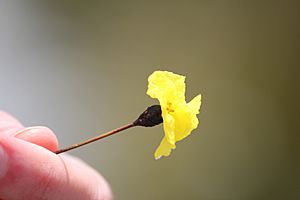Alpine yellow eye facts for kids
Quick facts for kids Alpine yellow eye |
|
|---|---|
 |
|
| Scientific classification | |
| Genus: |
Xyris
|
| Species: |
marginata
|
Xyris marginata, also known as the alpine yellow eye, is a special plant. A German-Australian botanist named Ferdinand von Mueller first found it in 1875. This plant is a type of monocot, which means it's a flowering plant with one seed leaf. It belongs to the family Xyridaceae.
You can find Xyris marginata only on King Island (Tasmania) and in Tasmania. It often grows in wet, open areas called button grass moorlands. These areas can be very high up, sometimes over 1000 meters (about 3,500 feet) above sea level.
Contents
What's in a Name? (Taxonomy)
The name Xyris comes from an old word related to "iris." This is probably because many plants in both groups have bright yellow flowers. The second part of its name, Marginata, describes its leaves. It means the edges of its leaves are tightly rolled.
There are four types of Xyris plants that grow naturally in Tasmania. They are Xyris marginata, Xyris muelleri, Xyris operculata, and Xyris tasmanica. All of them like to grow in wet soils and swamps. Xyris marginata is special because it can live in the highest places. Xyris operculata is the only one that isn't found only in Tasmania.
What Does it Look Like? (Description)
Xyris marginata grows in high, open areas called moors. You can easily spot it by its bright yellow flowers and its twisting stems. The plant's main stalk grows from its roots and can be between 15 and 55 centimeters (about 6 to 22 inches) tall. It forms small clumps and lives for many years.
Like other Xyris plants in Tasmania, Xyris marginata flowers between November and January. Its flower head is wider at the top, almost like a ball. The petals are round and a beautiful golden yellow. They have tiny, jagged edges, which is how Xyris marginata got its name.
The leaves are thick and have a strong central line. They are usually dark brown and shiny. The edges of the leaves are rounded, except for the tip, which is pointed like an awl. The leaves grow in a spiral shape from the bottom of the plant.
How is it Different from Similar Plants?
Plants in the Xyridaceae family are usually clumpy herbs that live for many years. Their leaves grow from the bottom and are arranged in a spiral. The flowers are round, and all Tasmanian types have yellow flowers. They usually have three sepals (leaf-like parts protecting the bud), three petals, and three stamens (parts that make pollen). How high up the plant grows is also a clue. Xyris marginata is tough enough to survive at high altitudes, unlike most other types.
You can tell Xyris operculata (A) apart from Xyris marginata (B) by its thin, straight leaves. Xyris marginata has leaves that look more like springs. Also, Xyris operculata has three extra hairy tufts near its regular stamens. Xyris muelleri (C) has leaves that curl upwards and are pointy at the ends. Its petals have smooth edges. Xyris tasmanica (D) also has smooth petal edges like C, but its leaves don't grow close to the flower head.
Where Does it Grow? (Distribution and Habitat)
You can find Xyris marginata in wet, open areas called heaths. It grows on King Island and in different parts of Tasmania, like the northwest, west, east, and southwest coasts.
Button grass moorlands are where Xyris marginata often lives. These moorlands cover about 14% of Tasmania. They include high mountain areas in western and southwestern Tasmania, and lower areas in the east. The Tasmanian Government's Department of Primary Industries, Parks, Water and Environment (DPIPWE) says these moorlands are places where plants are less than two meters tall. The plant called 'button grass' (Gymnoschoenus sphaerocephalus) is usually the main plant there.
Its Home Environment (Ecology)
The most important plant in button grass marshes is the Gymnoschoenus sphaerocephalus or 'button grass'. This is why these areas are named after it. The soil in these moorlands can be very thin, sometimes only 1 centimeter thick. Below that, you might find mineral soils or often quartz gravel.
Button grass moorlands can grow on flat ground, slopes, ridges, and mountain tops. They can also have frequent fires. The soils are usually not very rich in nutrients and don't drain water well. Even so, about 272 different kinds of vascular plants (plants with tubes for water and nutrients) grow here. About one-third of these plants are found only in Tasmania.
Keeping it Safe (Conservation)
There are no special plans just for Xyris marginata. However, the moorlands where it lives are protected by the DPIPWE. Most of these moorlands are owned by the public and managed by the DPIPWE. Xyris marginata is good at resisting invasive weeds (plants that spread easily and harm native plants). Sometimes, controlled burning is done to help manage these areas.
See Also
- Xyris

